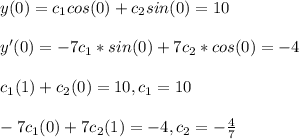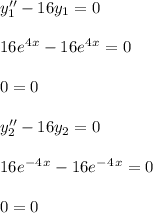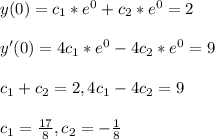
Mathematics, 01.07.2020 15:01 182075
A homogeneous second-order linear differential equation, two functions y 1y1 and y 2y2, and a pair of initial conditions are given. First verify that y 1y1 and y 2y2 are solutions of the differential equation. Then find a particular solution of the form y = c1y1 + c2y2 that satisfies the given initial conditions. Primes denote derivatives with respect to x.
y'' + 49y = 0; y1 = cos(7x) y2 = sin(7x); y(0) = 10 y(0)=-4
1.Why is the function y, = e * a solution to the differential equation?
A. The function y1 =e 4X is a solution because when the function and its indefinite integral, , are substituted into the equation, the result is a true statement.
B. The function y1 = e 4X is a solution because when the function and its second derivative, y1" = 16 e 4x, are substituted into the equation, the result is a true statement.
2. Why is the function y2 solution the differential equation?
A. The function y2 = e 4x is a solution because when the function and its indefinite integral, are substituted into the equation, the result a true statement. The function y2 = e 4X is a solution because when the function and its second derivative, y2" = 16 e -4x are substituted into the equation, the result is a true statement. The particular solution of the form y = c, y, +c, y2 that satisfies the initial conditions y(0) 2 and y'(0) = 9 is y =.

Answers: 3
Another question on Mathematics


Mathematics, 21.06.2019 23:10
Frank is lending $1,000 to sarah for two years. frank and sarah agree that frank should earn a real return of 4 percent per year. instructions: a. the cpi (times 100) is 100 at the time that frank makes the loan. it is expected to be 113 in one year and 127.7 in two years. what nominal rate of interest should frank charge sarah?
Answers: 3


Mathematics, 22.06.2019 01:50
Order the equations from least to greatest based on the number of solutions to each equation.-4^x -1 = 3^(-x) – 2 -3x + 6 = 2^x+13^x – 3 = 2x - 2
Answers: 1
You know the right answer?
A homogeneous second-order linear differential equation, two functions y 1y1 and y 2y2, and a pair o...
Questions


English, 23.05.2021 17:40

Mathematics, 23.05.2021 17:40


Mathematics, 23.05.2021 17:40

Social Studies, 23.05.2021 17:40


Mathematics, 23.05.2021 17:40


Mathematics, 23.05.2021 17:40

English, 23.05.2021 17:50

Advanced Placement (AP), 23.05.2021 17:50

English, 23.05.2021 17:50

Mathematics, 23.05.2021 17:50

Mathematics, 23.05.2021 17:50


Social Studies, 23.05.2021 17:50


Physics, 23.05.2021 17:50

Business, 23.05.2021 17:50


















 .... Answer
.... Answer

